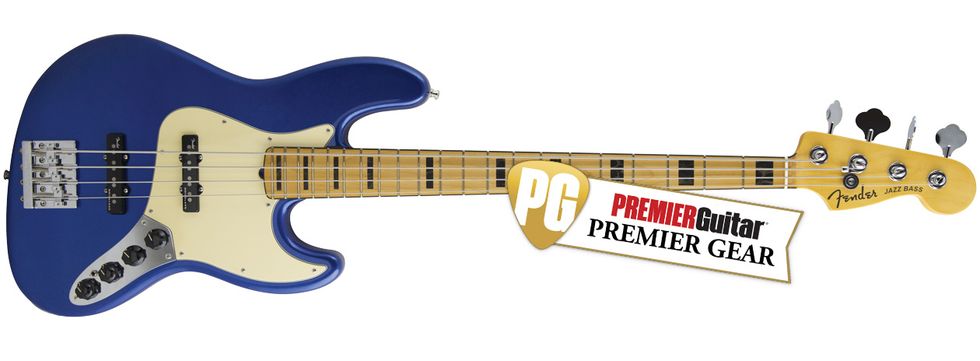* All clips recorded direct into Avid Mbox into Logic X.
Clip 1: Passive mode with both pickups at full volume. Tone at 80 percent.
Clip 2: Passive mode with neck pickup at 75 percent and bridge at 25 percent. Tone dial at 30 percent.
Clip 3: Active mode with both pickups at full volume and slight bass boost.
RatingsPros:Stunning looks. Quiet, hum-free pickups. Fast playability. Great tonal versatility. Cons: Preamp not completely quiet. Limited color options. Street: $1,999 Fender American Ultra Jazz fender.com | Tones: Playability: Build/Design: Value: |
One might ask why we need another take on the Jazz bass, because how many improvements can you really make to greatness? And what's the big deal about the launch of an instrument that's almost the same as its predecessors? As somebody who has played a very wide variety of FSOs (Fender shaped objects) over the past 20 years, I had those thoughts before the arrival of the American Ultra Jazz.
Over the years, many manufacturers have taken the concept of the Jazz bass and made their own tweaks to the design while retaining much of the essence of the original. The process has been very similar to what happens in the custom motorcycle- and car-building worlds. How so? The designers in charge of conceiving new products for the original brand or model keep their eyes on the custom market, and take its innovations into consideration when redesigning or tweaking. I first noticed this with the launch of Fender's Elite series a few years back, and it was the quality and innovation of the Elite basses that drew me back to Fender. So, I was very curious to check out the new Ultra Jazz.
Blue Steel
When unpacking the Ultra, I was thrilled to see I had been sent a maple-fretboard version, which is adorned with block inlays and a black binding. (A rosewood fretboard is available with some of the other finish options.) It struck me upon closer inspection that the blocks are not black, to match the binding, but rather a black/brown tortoiseshell-looking shade. It's a subtle but upscale detail that hints you're looking at a top-of-the-line Jazz. The logo is inscribed in gold on a chrome hardware bass, which is rare, but flows nicely with the yellowish hue of the maple.
The Ultra Jazz falls into the medium weight category at about 9 1/4 pounds, and the action was set up perfectly at the factory—something I rarely encounter. The cobra-blue color on our test bass is absolutely ravishing. So much so that it garnered several adoring comments about its “impossibly good looks" from all-black-wearing rocker types at a gig on Hollywood's Sunset Strip.
Small Changes, Big Difference
The new Ultra Jazz is certainly a looker, but how about the feel? When initially playing the Ultra, two of its new features were glaringly obvious in five seconds. First, the satin finish on the back of the neck makes the bass beg for faster licks than I should probably be playing on a gig. The natural wood feel is retained with the artfully applied finish, while the neck is still protected from the outside world. Second, the rounded heel makes access to the upper frets of the instrument very accessible—a modern design touch, indeed.
Speaking of modern, the updated neck shape for the Ultra is what Fender calls a “modern-D" shape, which equates to a little more meat on the shoulders and being slightly flatter in the upper register. I have played J basses where I had wished for a bit more to grab onto in the lower register, and this bass gets it right.
I wanted to know what many players would likely be concerned about when playing the modern version of this classic: Does it sound like a proper J in passive mode? With the pickup selector control set right in the middle and the tone control rolled off ever so slightly, the bass delivered the robust, growly fingerstyle tone that a Jazz bass has to be able to offer. The midrange is wonderfully present without any of the hollow quality that sometimes plagues less-than-perfect Jazz-style instruments. I had a hard time forcing myself to dial in other tones, simply because the home-base sound was so good.
I don't rely on the bridge pickup that often, but of course I had to see if this modern version of the Jazz could deliver in the Jaco zone. I rolled off the passive tone control to about one-third open and favored the bridge pickup at 75 percent, keeping a slight amount of neck pickup in the mix for low-end retention. Instantly, that classic midrange and burpy bark was present in full force. I was also pleasantly surprised with the fullness of the 1st and 2nd strings with the bridge pickup favored—a big selling point for me.
System Activated
Fender's new active preamp was designed especially for the Ultra series and is engaged by a mini toggle switch located on the bottom half of the control plate. With the preamp on, the passive tone dial—located on the bottom portion of the rear concentric control set—becomes inactive and the 3-band EQ becomes active. With a preamp in a Jazz bass with a maple neck, the bass gods required an attempt at Marcus Miller-type tone, and man, was it easy to find. With just a slight boost of the low end on the onboard pre, Miller's clean, scooped, and big slap tone was there to be devoured.
Playing fingerstyle with the active mode engaged creates a quite different voice than in passive mode. I was content with the EQ flat, but with a little boost of the onboard midrange control, the maple-neck bark that I loved so much in passive mode is retained, and the personality of the instrument—not the preamp—is still front and center. I feel that Fender's preamp compliments the instrument rather than changes it completely, which all too often is the case with onboard preamps. I did notice a very small hiss from the preamp while recording the Ultra Jazz direct. This is pretty common, however, and wasn't audible at all when playing though an amp.
The Verdict
It's obvious Fender has spent a lot of time in R&D for the American Ultra Jazz. The changes and updates to the look and design are both clever and commonsense. The attention to detail warrants the price tag—which is still positioned below many other bass makers' boutique Jazz-style instruments. The easy playability and astoundingly wide tonal palette between the passive and active modes make for strong selling points. This new version of a classic feels different than other Fenders in the ways it should feel different, yet it sounds like the classic when called upon to do so. Please excuse the overused descriptor, but the Swiss Army Jazz is here.









![Rig Rundown: AFI [2025]](https://www.premierguitar.com/media-library/youtube.jpg?id=62064741&width=1245&height=700&quality=70&coordinates=0%2C0%2C0%2C0)












 Shop Scott's Rig
Shop Scott's Rig















































